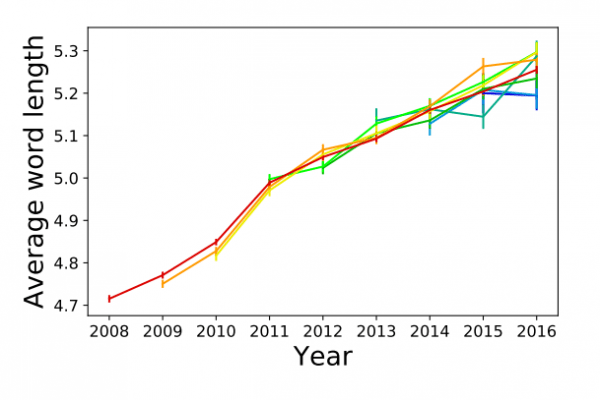

The world of social media fills our lives and those of our children. Parents and teachers, in particular, wage a daily war with young people about the amount of time they spend on social media. At issue is the correct balance of screen time and physical activity.
Recommended for You
-
First Human Embryos Edited in U.S.
-
The Tech World Is Convinced 2021 Is Going to Be the Best Year Ever
-
How the “Gangnam Style” Video Became a Global Pandemic
-
A DNA App Store Is Here, but Proceed with Caution
-
The Emerging Science of Computational Psychiatry
There are obvious health implications from being glued to a screen for 18 hours a day that physical activity can alleviate. But another fear is that the way young people use language on social media is evidence of a kind of linguistic degradation. The worry is that using emoticons, acronyms, and loose grammar is a recipe for future disaster. But is this true?
Today we get an answer of sorts thanks to the work of Ivan Smirnov at the National Research University Higher School of Economics in Moscow. Smirnov has studied the complexity of messages sent over social media and the way they have changed over time. And his conclusion is as surprising as it is counterintuitive.

Smirnov begins with a data set of messages posted online between 2008 and 2016 by almost a million people in St. Petersburg. The messages were posted to a Russian social-media site called VK, which is similar to Facebook, and include a total of more than one billion words. The data set also includes the posters’ ages along with the schools from which they graduated.
Smirnov then asks an interesting question—how has the complexity of these messages changed over time?
Complexity is a tricky notion to measure. Sentences in social media are harder to gauge than traditional texts because they do not always contain conventional punctuation—emoticons can sometimes play the same role as full stops, for example.
So Smirnov uses average word length as a proxy for message complexity on the assumption that, on average, longer words convey more complex messages. He then analyzes the data to see how it has changed over time, how an individual’s message complexity changes with age, and how message complexity varies with educational attainment, as measured by school affiliation.
The results make for interesting reading. Smirnov says that people’s messages become more complex as they get older through their 20s. “It is relatively stable through the 30s and increases again starting from the early 40s,” he says. People with higher educational attainment also tend to write more complex messages.
But the surprising finding is that message complexity has increased over time to an even greater extent. “We find that the complexity of posts is constantly increasing, and that this increase cannot be explained by aging alone,” says Smirnov.
Some of this increase can be explained by changes in technology. Smirnov saw a particularly big increase in message complexity in 2011 that was probably the result of an improved interface that allowed people to post messages more easily.
But the more general increase in complexity is a puzzle. And it is dramatic, too: “15-year-old users in 2016 wrote more complex posts than users of any age in 2008,” he says.
He likens this to the Flynn effect, the substantial and sustained increase in measured IQ among people all over the world since the 1930s. The effect is so great that the average IQ of people in the U.S. in 1930 is less than 80 by modern standards (by definition, the average IQ should be 100).
Nobody is quite sure how this increase in IQ has happened, but potential explanations include better nutrition, better education, smaller families, familiarity with the tests, and so on.
Smirnov calls the rise in complexity of social-media messages the digital Flynn effect. But he offers little in the way of potential explanations. One idea is that people might write more complex messages as they become more familiar with the technology, but it is not clear how this can explain why 15-year-olds today write more complex messages than people of any age in 2008.
So there is an interesting mystery here that linguists, sociologists, and data analysts might have some fun teasing apart. As for parents and teachers, they might take another message from this work: this data suggests that social media does not stunt intellectual development. On the contrary, it seems to allow it to flourish. But again, that’s a conclusion that will need significant more work to cement.
[Source::-technologyreview]

